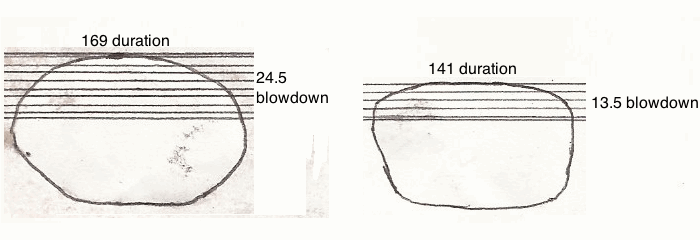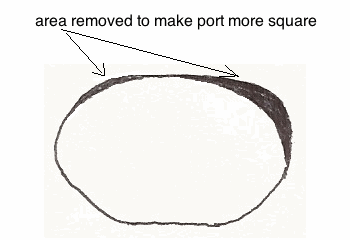|
I used to think that the port duration was the most important factor when porting for a certain peak RPM. More duration equates to higher RPM. Everyone believes that and there are places on the internet that prescribe different port durations for different peak RPM. (That's good and I do the same but it's not the whole story.) I then compared two cylinders with everything the same except for the exhaust and transfer port durations. One had degrees duration of 141 exhaust and 114 transfers, whereas the other had 169 exhaust and 120 transfers. The blowdown time of millisecons between exhaust opening and transfers opening hopefully provides enough time for the exhaust gas to mostly leave before the transfers open at high RPM. If there is too little blowdown then that delays the entrance of the intake through the transfers at top RPM.  Surprisingly, the one with the least port durations rev'd 300 RPM more (although it had weaker acceleration). The main reason probably was that when you raise the exhaust port you lessen the trapped engine volume, in this case from 45cc to 38cc. So the cylinder with 141 degrees exhaust duration had 17% more true engine volume than the other cylinder. The common formula for engine size is cm bore squared times cm stroke times .7854 which means it is ignoring the volume above the exhaust port so it's not a good way to figure engine size. The only true way to calulate it is figuring the volume above the port. Formula: cm bore/2 squared times 3.14 times (cm stroke above exhaust port + equivalent head stroke). Equiv head stroke = stroke above exhaust port (to TDC point) divided by (compression ratio -1). The second reason had to do with the upper port shape. The exhaust port with 142 duration had more of a squared-off shape at the top, and the other one was much more rounded. Thinking about it I realized that more open area at the beginning of the port opening not only increased the exhaust flow at the beginning, but also all the way till the transfers open. It's like each new open area for each new 5 degrees of crank movement (as the piston descends) incorporates that beginning area also. So I did a numerical analysis and the square port design actually had 12% more accumulative area than the other for the same beginning 5mm of piston descent (which equates to the 142/114* cylinders blowdown time). Here you can see how I modified the 169 duration port to get 500 more RPM:  Then I began to wonder why there's so much paranoia about a near-square exhaust port design. People are so worried about the ring expanding out into the exhaust port that they always recommend a roundish design. But consider this: the rings are trying even harder to push outward into the transfers than they are into the exhaust port. That is because the rings at the exhaust are basically the middle of the rings and the sides of the rings are located at the transfers. When you squeeze the rings shut when installing the piston/rings into the cylinder notice how it's the sides of the rings that move toward the center point, not the middle of the ring. So look at how wide the transfers are at their straight tops and by that you know how wide a straight center portion of the exhaust port can be. So if you port for a target RPM and don't achieve it then consider squaring the exhaust port top little by little until you get the speed you want. But know that a rounded top preserves mid range power better than a square top. Maximum straight line port width is .65 of bore or .70 if you plan on replacing the rings often. Make generous chamfers at 10 degrees. I then moved on to study the transfer ports and found out some key factors that made the engine with short durations rev higher. Click here to read about it. |